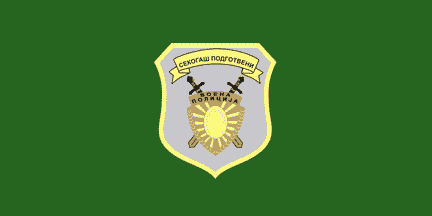

Last modified: 2008-11-29 by ivan sache
Keywords: army |
Links: FOTW homepage |
search |
disclaimer and copyright |
write us |
mirrors
See also:
The flag of the 1st Motorised Infantry Brigade, as shown on the website of the Ministry of Defense of the Republic of Macedonia, is red with the national coat of arms and the brigade emblem, and the name of the unit in yellow Cyrillic scripts.
Valentin Poposki, 9 March 2007
The flag of the Armoured Battalion, as shown on the website of the Ministry of Defense of the Republic of Macedonia, is yellow with the battalion emblem and the name of the unit in black Cyrillic letters.
Valentin Poposki & Ivan Sache, 9 March 2007
The flag of the Air Defense Battalion, as shown on the website of the Ministry of Defense of the Republic of Macedonia, is light blue with the emblem of the Joint Operations Command and the battalion emblem, and the name of the unit in black Cyrillic letters.
Valentin Poposki & Ivan Sache, 10 March 2007
The flag of the 1st Battery of the Air Defense Battalion, as shown on the website of the Ministry of Defense of the Republic of Macedonia, is light blue, swallow-tailed with the emblems of the Air Defense Battalion and of the 1st Battery, and the name of the unit in black Cyrillic letters.
Valentin Poposki & Ivan Sache, 11 March 2007
The flag of the Commanding Battery of the Air Defense Battalion, as shown on the website of the Ministry of Defense of the Republic of Macedonia, is light blue, swallow-tailed with the emblems of the Air Defense Battalion and of the Commanding Battery, and the name of the unit in black Cyrillic letters.
Valentin Poposki & Ivan Sache, 13 March 2007
Flag of the Military Police - Image by Jovan Jonovski, 14 March 2007
The flag is green with the Military Police emblem in the middle. The image is based on a photograph published in a local Macedonian newspaper.
Valentin Poposki, 14 March 2007
The flag of the Nuclear, Biological and Chemical Defense Company, as shown on the website of the Ministry of Defense of the Republic of Macedonia, is blue with a thin yellow border and the emblem of the company.
The emblem is charged with the Latin acronym "ABHO"(for "Nuclear, Biologic and Chemical Defences" and the Cyrillic motto ОТКРИЈ И
УНИШТИ (Detect and Destroy).
Valentin Poposki & Ivan Sarajčić, 15 March 2007
The flag of the Combat Helicopter Squadron, as shown on the website of the Ministry of Defense of the Republic of Macedonia, is light blue with the emblem of the squadron.
The Latin motto of the squadron, Acerbus et Ingens (Fierce and Mighty), is written in yellow below the squadron emblem.
Valentin Poposki & Ivan Sache, 26 March 2007
The flag of the Reconnaissance Squadron, as shown on the website of the Ministry of Defense of the Republic of Macedonia, is light blue with the emblem of the squadron.
Valentin Poposki & Ivan Sarajčić, 17 March 2007
The flag of the Training Squadron of the Air Force Wing, as shown on the website of the Ministry of Defense of the Republic of Macedonia, is blue with the emblem of the squadron.
The Latin motto of the squadron, Per aspera ad astra (Through difficulties to the stars), written in yellow below the squadron emblem, is used by the US state of Kansas. A similar motto, Per ardua ad astra (Through struggle to the stars), is used by the Royal Air Force and other Commonwealth air forces. Quoting the RAF website (page no longer online):
As far as can be ascertained, the motto of the Royal Air Force dates back to 1912 and the formation of the Royal Flying Corps (RFC). The first Commanding Officer of the RFC (Military Wing) was Colonel Frederick Sykes. He asked his officers to come up with a motto for the new service; one which would produce a strong esprit de corps. Shortly after this, two junior officers were walking from the Officers' Mess at Farnborough to Cody's Shed on Laffan Plain. As they walked, they discussed the problem of the motto and one of them, JS Yule, mentioned the phrase Sicictar ad Astra, from the Virgilian texts. He then expanded on this with the phrase Per Ardua ad Astra, which he translated as, "Through Struggles to the Stars". Colonel Sykes approved of this as the motto and forwarded it to the War Office. It was then submitted to the King, who approved its adoption.
The question of where this motto had come from can be answered by he fact that Yule had read it in a book called "People of the Mist" by Sir Henry Rider Haggard. In the first chapter was the passage, "To his right were two stately gates of iron fantastically wrought, supported by stone pillars on whose summit stood griffins of black marble embracing coats of arms and banners inscribed with the device Per Ardua ad Astra".
As to where Sir Rider Haggard obtained this phrase is still unclear although it is possible that it originated from the Irish family of Mulway who had used it as their family motto for hundreds of years and translated it as "Through Struggles to the Stars".
Valentin Poposki & Ivan Sache, 19 March 2007